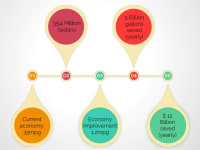INTRODUCTION
A major contributor to global warming is the burning of fossil fuels for various activities. Passenger cars consume billions of gallons of petrol or its derivatives each year to power their internal combustion engines. About 53% of usable energy from the engine goes into overcoming aerodynamic drag. Nearly 40% of the car’s drag is because of eddies formed at the rear of the vehicle. With this critical point in mind, we started exploring options to reduce the drag coefficient of automobiles using devices that are inexpensive, easy to use and effective.
CONCEPTUALIZATION
It was analyzed and observed that pressure drag due to flow separation constitutes more than 80% of the total aerodynamic drag [2]. Flow separation takes place at the rear end of the car, leaving swirling eddy flow. To eliminate drag due to flow separation, the posterior end of the car needs to be modified to a tapered surface.
HOW THE DESIGN WORKS
Adding the appendage at the end of the vehicle would increase its length, making parking a nuisance. Hence there was a need to make it collapsible and packable. The inner face of the appendage has 4 pouches stitched housing magnets which would keep it attached to the car. Once the car starts moving, the air pump will inflate the appendage to the required pressure. When the car is not in use, a valve can be opened to deflate the appendage and store it.
ONE OF ITS KIND
The current marketplace has products which serve only pickup trucks. Limitations of the products currently available in the market include: only applicable to pickup trucks, they are very expensive (> 700 $). This expensive cost prevents many people from purchasing the product to improve their mileage. The flexibility of this product enables it to be applied to virtually any automobile-hatchbacks, sedan and jeeps and its simplicity makes it easy to use.
MARKET POTENTIAL
In the past there have been no such products developed for vehicles other than pickup trucks. The product that we present here is cost effective and economical. This expands the product market for the product enabling it to be purchased by the common man. The product is easily attachable, detachable and, most importantly, flexible. The flexibility of this product enables it to be applied to virtually any automobile-hatchbacks, sedan and jeeps.
IMPACT
A drag reduction of 27% which we achieved through our simulation has the following impact:
Economic Impact:
Reduction in drag coefficient by 0.01 increases the fuel economy by 0.2 mpg. With our product there will be a 1.2 mpg improve in the fuel economy. Five billion gallons and 12.2 billion dollars can be saved considering that there are 354 million sedans in the world.
Environmental Impact:
Improving aerodynamic efficiency reduces fuel consumption, thereby leading to less pollution and a decrease in the rate of global warming. Combustion of 1 gallon of gasoline results in 8.15kg of carbon dioxide emissions. Hence there will be 3.25% reduction in carbon dioxide emissions yearly.
Like this entry?
-
About the Entrant
- Name:Farhan Javed
- Type of entry:teamTeam members:1.Farhan Javed
2.Salman Javed
3.D.Harish - Software used for this entry:Solidworks , Ansys
- Patent status:none








